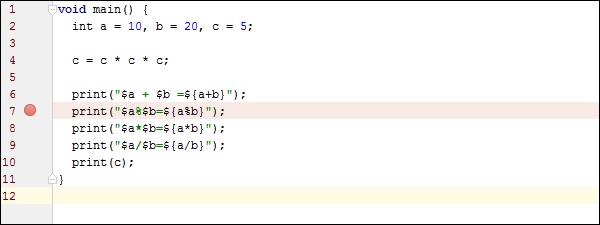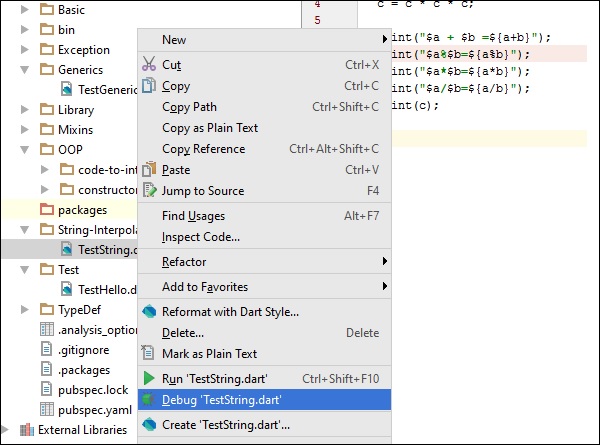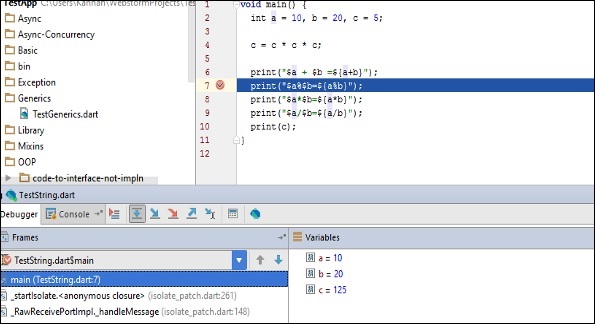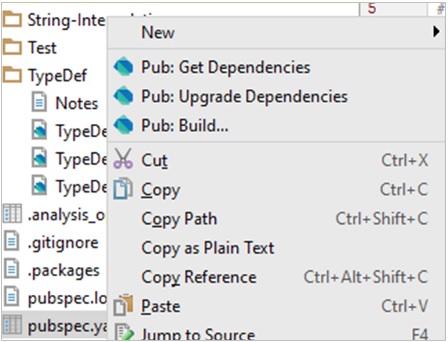A library in a programming language represents a collection of routines (set of programming instructions). Dart has a set of built-in libraries that are useful to store routines that are frequently used. A Dart library comprises of a set of classes, constants, functions, typedefs, properties, and exceptions.
Importing a library
Importing makes the components in a library available to the caller code. The import keyword is used to achieve the same. A dart file can have multiple import statements.
Built in Dart library URIs use the dart: scheme to refer to a library. Other libraries can use a file system path or the package: scheme to specify its URI. Libraries provided by a package manager such as the pub tool uses the package: scheme.
The syntax for importing a library in Dart is given below −
import 'URI'
Consider the following code snippet −
import 'dart:io'
import 'package:lib1/libfile.dart'
If you want to use only part of a library, you can selectively import the library. The syntax for the same is given below −
import 'package: lib1/lib1.dart' show foo, bar;
// Import only foo and bar.
import 'package: mylib/mylib.dart' hide foo;
// Import all names except foo
Some commonly used libraries are given below −
| Sr.No | Library & Description |
|---|---|
| 1 | dart:ioFile, socket, HTTP, and other I/O support for server applications. This library does not work in browser-based applications. This library is imported by default. |
| 2 | dart:coreBuilt-in types, collections, and other core functionality for every Dart program. This library is automatically imported. |
| 3 | dart: mathMathematical constants and functions, plus a random number generator. |
| 4 | dart: convertEncoders and decoders for converting between different data representations, including JSON and UTF-8. |
| 5 | dart: typed_dataLists that efficiently handle fixed sized data (for example, unsigned 8 byte integers). |
Example : Importing and using a Library
The following example imports the built-in library dart: math. The snippet calls the sqrt() function from the math library. This function returns the square root of a number passed to it.
import 'dart:math';
void main() {
print("Square root of 36 is: ${sqrt(36)}");
}Output
Square root of 36 is: 6.0
Encapsulation in Libraries
Dart scripts can prefix identifiers with an underscore ( _ ) to mark its components private. Simply put, Dart libraries can restrict access to its content by external scripts. This is termed as encapsulation. The syntax for the same is given below −
Syntax
_identifier
Example
At first, define a library with a private function.
library loggerlib;
void _log(msg) {
print("Log method called in loggerlib msg:$msg");
} Next, import the library
import 'test.dart' as web;
void main() {
web._log("hello from webloggerlib");
} The above code will result in an error.
Unhandled exception:
No top-level method 'web._log' declared.
NoSuchMethodError: method not found: 'web._log'
Receiver: top-level
Arguments: [...]
#0 NoSuchMethodError._throwNew (dart:core-patch/errors_patch.dart:184)
#1 main (file:///C:/Users/Administrator/WebstormProjects/untitled/Assertion.dart:6:3)
#2 _startIsolate.<anonymous closure> (dart:isolate-patch/isolate_patch.dart:261)
#3 _RawReceivePortImpl._handleMessage (dart:isolate-patch/isolate_patch.dart:148)
Creating Custom Libraries
Dart also allows you to use your own code as a library. Creating a custom library involves the following steps −
Step 1: Declaring a Library
To explicitly declare a library, use the library statement. The syntax for declaring a library is as given below −
library library_name
// library contents go here
Step 2: Associating a Library
You can associate a library in two ways −
- Within the same directory
import 'library_name'
- From a different directory
import 'dir/library_name'
Example: Custom Library
First, let us define a custom library, calculator.dart.
library calculator_lib;
import 'dart:math';
//import statement after the libaray statement
int add(int firstNumber,int secondNumber){
print("inside add method of Calculator Library ") ;
return firstNumber+secondNumber;
}
int modulus(int firstNumber,int secondNumber){
print("inside modulus method of Calculator Library ") ;
return firstNumber%secondNumber;
}
int random(int no){
return new Random().nextInt(no);
}Next, we will import the library −
import 'calculator.dart';
void main() {
var num1 = 10;
var num2 = 20;
var sum = add(num1,num2);
var mod = modulus(num1,num2);
var r = random(10);
print("$num1 + $num2 = $sum");
print("$num1 % $num2= $mod");
print("random no $r");
} The program should produce the following output −
inside add method of Calculator Library
inside modulus method of Calculator Library
10 + 20 = 30
10 % 20= 10
random no 0
Library Prefix
If you import two libraries with conflicting identifiers, then you can specify a prefix for one or both libraries. Use the ‘as’ keyword for specifying the prefix. The syntax for the same is given below −
Syntax
import 'library_uri' as prefix
Example
First, let us define a library: loggerlib.dart.
library loggerlib;
void log(msg){
print("Log method called in loggerlib msg:$msg");
} Next, we will define another library: webloggerlib.dart.
library webloggerlib;
void log(msg){
print("Log method called in webloggerlib msg:$msg");
} Finally, we will import the library with a prefix.
import 'loggerlib.dart';
import 'webloggerlib.dart' as web;
// prefix avoids function name clashes
void main(){
log("hello from loggerlib");
web.log("hello from webloggerlib");
} It will produce the following output −
Log method called in loggerlib msg:hello from loggerlib
Log method called in webloggerlib msg:hello from webloggerlib





